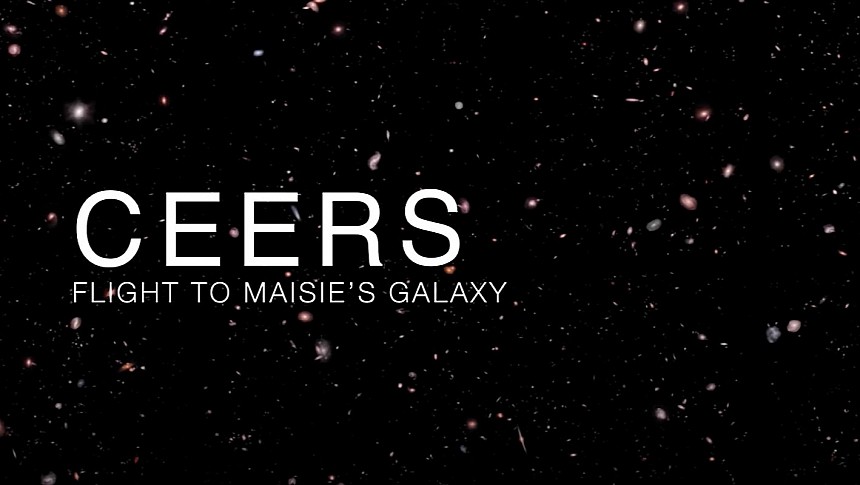Earlier this week we got news from NASA that the James Webb Space Telescope discovered what will be for a while the oldest and most distant active black hole known to man. The discovery was not made possible by the telescope alone, but also thanks to something called CEERS.
Being such an important and internationally backed project, the Webb telescope needs to be shared between various organizations and scientists, each of them looking to advance their own goals and agendas through specific programs.
CEERS, which stands for Cosmic Evolution Early Release Science, is a cooperative effort between a large number of scientists from several academic institutions. Its main goal is to look at the very distant Universe, in both space and time, and find new galaxies, stars, and black holes, among others, as a means to find out when the first such formations and space objects were born, and how they evolved.
The program kicked off as soon as Webb reached its place in the sky from where to spy on the great unknown, and has already revealed incredible things about the Universe and its distant past.
Part of the CEERS work can be seen in the video attached below, but you have to be warned, the short clip might leave you speechless, especially if you are aware of the things you're looking at.
The clip is relatively short, just a little over a minute, but moves everyone watching, surrounded by soothing music, 13.4 billion years into the past and across no less than 5,000 galaxies.
NASA calls this exercise a visualization, something we're used to getting from the space agency. In this case, the images show a small portion of the sky known from the days of the Hubble Space Telescope as the Extended Groth Strip. That's an area spreading between two major constellations, Ursa Major and Bootes.
The Strip is home to an estimated 100,000 galaxies, but the NASA clip shows just 5,000 of them, the ones that happen to be on the way to a galaxy called Maisie's.
By all accounts, Maisie's Galaxy is the most distant known galaxy, having formed just 390 million years after the Big Bang. On a human scale, that makes it at least 13.4 billion years old, and one of the highlights of Webb's activity so far, as the world's most expensive telescope is responsible for us knowing about it.
"We couldn’t study galaxies like Maisie's before because we couldn't see them. Now, not only are we able to find them in our images, we're able to find out what they're made of and if they differ from the galaxies that we see close by," said in a statement Rebecca Larson from the Rochester Institute of Technology.
And what we can see below is only the beginning, as there seems to be no limit to how many galaxies Webb can find. In fact, scientists say we're to expect most optimistic estimates to be at least met, if not surpassed, in terms of both volume and quantity of data.
CEERS, which stands for Cosmic Evolution Early Release Science, is a cooperative effort between a large number of scientists from several academic institutions. Its main goal is to look at the very distant Universe, in both space and time, and find new galaxies, stars, and black holes, among others, as a means to find out when the first such formations and space objects were born, and how they evolved.
The program kicked off as soon as Webb reached its place in the sky from where to spy on the great unknown, and has already revealed incredible things about the Universe and its distant past.
Part of the CEERS work can be seen in the video attached below, but you have to be warned, the short clip might leave you speechless, especially if you are aware of the things you're looking at.
The clip is relatively short, just a little over a minute, but moves everyone watching, surrounded by soothing music, 13.4 billion years into the past and across no less than 5,000 galaxies.
NASA calls this exercise a visualization, something we're used to getting from the space agency. In this case, the images show a small portion of the sky known from the days of the Hubble Space Telescope as the Extended Groth Strip. That's an area spreading between two major constellations, Ursa Major and Bootes.
The Strip is home to an estimated 100,000 galaxies, but the NASA clip shows just 5,000 of them, the ones that happen to be on the way to a galaxy called Maisie's.
By all accounts, Maisie's Galaxy is the most distant known galaxy, having formed just 390 million years after the Big Bang. On a human scale, that makes it at least 13.4 billion years old, and one of the highlights of Webb's activity so far, as the world's most expensive telescope is responsible for us knowing about it.
"We couldn’t study galaxies like Maisie's before because we couldn't see them. Now, not only are we able to find them in our images, we're able to find out what they're made of and if they differ from the galaxies that we see close by," said in a statement Rebecca Larson from the Rochester Institute of Technology.
And what we can see below is only the beginning, as there seems to be no limit to how many galaxies Webb can find. In fact, scientists say we're to expect most optimistic estimates to be at least met, if not surpassed, in terms of both volume and quantity of data.









